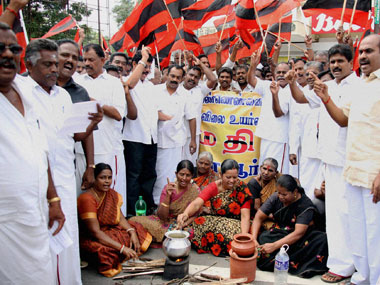If a salesman asked you whether you would like to buy something at a cost of Rs 100 today or Rs 105 tomorrow, you would probably choose the first option.
Most governments are different. Faced with the choice of spending a little bit of political capital today as against a larger amount tomorrow, most opt for the former.
Politicians want to eat their cake today, assuming there are no costs attached. They are always hoping that come tomorrow, some miraculous event will help them avoid the costs they have incurred in eating the cake today.
This is how the UPA government lost the battle against inflation in 2008-11. Miracles did happen (the global deflation in 2008-09, a good monsoon in 2010), but they came too little, too late.
[caption id=“attachment_33619” align=“alignleft” width=“380” caption=“Inflation has also eroded the value of people’s savings, necessitating higher interest rates. PTI”]  [/caption]
The broad policy was to spend heavily in rural areas, and protect the urban and rural population from the impact of higher prices (especially oil) through subsidies.
In doing so, the UPA incurred a bill of over Rs 5,80,000 crore to get itself re-elected by spending money on the poor, the rich, the farmers, and the urban middle-class. And this figure excludes many, many things like food and fertiliser subsidies, and normal spending in rural areas for building infrastructure, et al, which are anyway long-running spending programmes.
This is how Firstpost arrived at the Rs 5,80,000 crore number:
• Subsidies or oil bonds paid out to oil companies during 2005-11: Rs 2,23,203 crore
• Debt relief to farmers in run-up to 2009 general election: Rs 72,000 crore
Impact Shorts
More Shorts• Economic stimulus to Indian industry in 2008-09: Rs 1,86,000 crore
• Expenditure on rural employment guarantees (2008-11): Approx Rs 1,00,000 crore
• Total spent on re-election hopes and inflation control: Rs 5,81,203 crore
Well, here’s the surprise. According to rating agency Crisil , during 2008-11, Indian consumers paid over Rs 5,80,000 crore as higher prices for food and other essentials due to a sharp increase in average inflation from 5 percent in the three years before to 8 percent in 2008-11.
The close equivalence between spends and the damage done by inflation is a coincidence - and anyway only a ballpark figure. But its importance is clear.
“The rise in inflation… eroded the purchasing power of money and inflated the consumption expenditure bill of Indian households,” says Dharmakirti Joshi, Chief Economist at Crisil.
The credit rating agency expects food inflation to stay high going forward. In an inflationary situation, higher food prices should be an incentive to enhance the production of food items. However, Crisil observes that this has not happened so far.
“In addition to price signals, productivity improvement in food/agriculture categories would require better technology and improved investments in irrigation. In the absence of these measures, high food inflation is here to stay,” the Crisil analysis says.
Crisil said inflation was uneven through 2008-11, with food items shooting items through the roof. “Food inflation was at 11.6 percent during 2008-09 to 2010-11, as compared to non-food inflation of 5.7 percent,” the study said.
Inflation has also eroded the value of people’s savings, necessitating higher interest rates. India’s domestic savings rate is around 25 percent of GDP. If one considers the Indian economy to be $1.5 trillion that should be $375 billion. A third of those savings have got eroded by inflation.
As inflation surges, rising interest rates affect credit growth and effectively slow down the economy. In one of his recent budget speeches, Finance Minister Pranab Mukherjee expressed the hope that economic growth would hit double-digits and inflation come down. What spendthrift policies have achieved are the opposite: double-digit inflation, and slower growth.
Four conclusions emerge from this analysis:
One, trying to save consumers from costlier oil or food only prolongs the agony and, in any case, it comes back as inflation. The benefits received by the consumer in terms of cheaper kerosene, cooking gas and diesel have been lopped off from other parts of his budget.
Two, if it’s not cost-push (through higher oil prices) inflation, we will get demand-pull inflation at a later date. Cost-push is often better, because it promotes conservation of scarce fossil fuels and improves the efficiency of energy use. Ditto for fertiliser.
Three, food inflation can only be tackled by long-term improvements in agricultural productivity - on which there is little action. If the government can spend five years trying to woo the electorate with NREGA and oil subsidies, it could have invested a tenth of that in farm productivity improvements to make sure there is enough food to moderate the inflation unleashed. It didn’t do so.
Four, there is no substitute for fiscal prudence. Pumping money into the economy for years on end is a surefire recipe for continuous inflation.
A caveat: Inflation has many contributing factors - commodity prices, excess money supply, and fiscal imprudence being some of them. Nobody can predict which particular factor caused how much inflation. But the bottomline is this: prudence pays.


)

)
)
)
)
)
)
)
)



